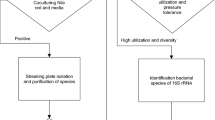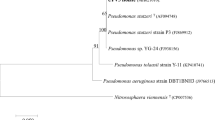Abstract
Based on DNA-cloning analysis, the microbial community of a phototrophic sludge producing H2 from an acidified wastewater was composed of 81% of a species resembling Rhodobacter capsulatus (with 99.2% similarity) and two unidentified species of the Bacillus/Clostridium group. The sludge produced a biogas comprising 82 ± 2% H2, 13 ± 2% CO2, 4.5 ± 0.5% N2, and 0.5 ± 0.2% H2S.
Similar content being viewed by others

References
Eroglu I, Aslan K, Gündüz U, Yücel M, Türker L (1998) Continuous hydrogen production by Rhodobacter sphaeroides OU 001. In: Zaborsky OR, Benemann JR, Miyake J, Pietro AS, eds., BioHydrogen. New York: Plenum Publishing, pp. 143–149.
Fang HHP, Liu H (2002) Effect of pH on hydrogen production from glucose by a mixed culture. Bioresource Technol. 82: 87–93.
Fang HHP, Liu H, Zhang T (2002) Characterization of a hydrogenproducing granular sludge. Biotech. Bioeng. 78: 44–52.
Fascetti E, Todini O (1995) Rhodobacter sphaeroides RV cultivation and hydrogen production in a one-and two-stage chemostat. Appl. Microbiol. Biotechnol. 44: 300–305.
Imhoff JF (1988) Anoxygenic phototrophic bacteria. In: Austin B, ed. Methods in Aquatic Bacteriology. New York: JohnWiley and Sons, pp. 207–240.
Lichtl RR, Bazin MJ, Hall DO (1997) The biotechnology of hydrogen production by Nostoc flagelliforme grown under chemostat conditions. Appl. Microbiol. Biotechnol. 47: 701–707.
Otsuki T, Uchiyama S, Fujiki K, Fukunaga S (1998) Hydrogen production by a floating-type photobioreactor. In: Zaborsky OR, Benemann JR, Miyake J, Pietro AS, eds., BioHydrogen. New York: Plenum Publishing, pp. 369–374.
Tsygankov AA, Fedorov AS, Laurinavichene TV, Gogotov IN, Rao KK, Hall DO (1998) Actual and potential rates of hydrogen photoproduction by continuous culture of the purple non-sulphur bacterium Rhodobacter capsulatus. Appl. Microbiol. Biotechnol. 49: 102–107.
Wu JH, Liu WT, Tseng IC, Cheng SS (2001) Characterization of a 4-methylbenzoate-degrading methanogenic consortium as determined by small-subunit rDNA sequence analysis. J. Biosci. Bioeng. 91: 449–455.
Yamada A, Hatano T, Matsunaga T (1998) Conversion efficiencies of light energy to hydrogen by a novel Rhodovulum sp. and its uptake-hydrogenase mutant. In: Zaborsky OR, Benemann JR, Miyake J, Pietro AS, eds. BioHydrogen. New York: Plenum Publishing, pp. 167–171.
Zhang T, Fang HHP (2001) Phylogenetic diversity of a SRB-rich marine biofilm. Appl. Microbiol. Biotechnol. 57: 437–440.
Zürrer H, Bachofen R (1979) Hydrogen production by the photosynthetic bacterium Rhodospirillum rubrum. Appl. Environ. Microbiol. 37: 789–793.
Author information
Authors and Affiliations
Rights and permissions
About this article
Cite this article
Zhang, T., Liu, H. & Fang, H.H. Microbial analysis of a phototrophic sludge producing hydrogen from acidified wastewater. Biotechnology Letters 24, 1833–1837 (2002). https://doi.org/10.1023/A:1020650313396
Issue Date:
DOI: https://doi.org/10.1023/A:1020650313396



